Two out of the five PMI components (output and employment) indicated better operating conditions, whereas the remaining three (new orders, stocks of purchases, and supplier delivery times) were consistent with a deterioration, according to JP Morgan’s Global Manufacturing PMI—a composite index produced by JP Morgan and S&P Global in association with ISM and IFPSM.
Global manufacturing production increased slightly in April, driven by improved supply-chain conditions and clearance of backlogs.
While output and employment showed improvement, new orders, stocks of purchases, and supplier delivery times deteriorated.
Employment rose slightly, and supply chain pressures eased, while input costs showed slower inflation.
Manufacturing output edged higher for the third successive month at the start of the second quarter. The upturn was mainly driven by a solid expansion in consumer goods production, while marginal growth was also signalled in the investment goods industry. The downturn in the intermediate goods category extended into its tenth consecutive month, although the rate of contraction was the weakest during that sequence.
Data broken down by nation indicated that output growth accelerated to an 11-month high in the US. An expansion was also signalled in China, in contrast to declines in Japan and the euro area.
Global manufacturing new orders continued to fall, however. The further deterioration in demand for goods was linked to the rising cost of living, a post-pandemic switch towards spending on services and a preference for lower inventory holdings by clients. New work received decreased in the intermediate and investment goods industries.
Although weaker inflows of new business raised the likelihood that once backlogs of work are cleared the trend in production volumes will soften, April data suggested that manufacturers expect any such slowdown to be short-lived. Business optimism rose to a 14-month high, with manufacturers forecasting (on average) growth of output over the coming year.
April saw a slight increase in manufacturing employment, the third in as many months. Growth was signalled in the intermediate and investment goods sectors and consumer goods producers registered no change. Job creation was seen in the US, the euro area, and Japan.
Average vendor performance improved for the third month running in April, signalling a further easing in supply chain pressures following the substantial disruption experienced through much of the past three years. Furthermore, lead times shortened to the greatest extent since May 2009.
April saw rates of increase in average input costs and selling prices ease to their lowest since June 2020 and September 2020, respectively. Both price measures signalled slower inflation in the consumer and investment goods sectors (with the steeper increases in the latter) in contrast to the declines registered in the intermediate goods category.
Fibre2Fashion News Desk (NB)







